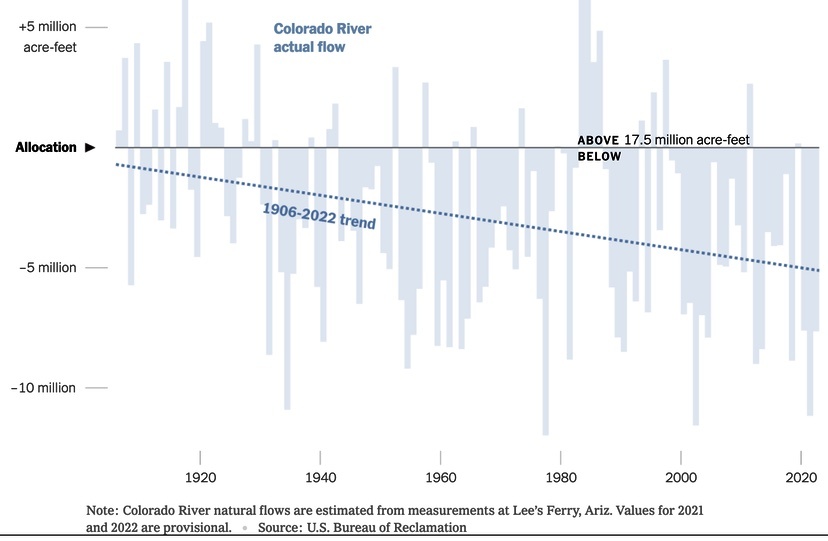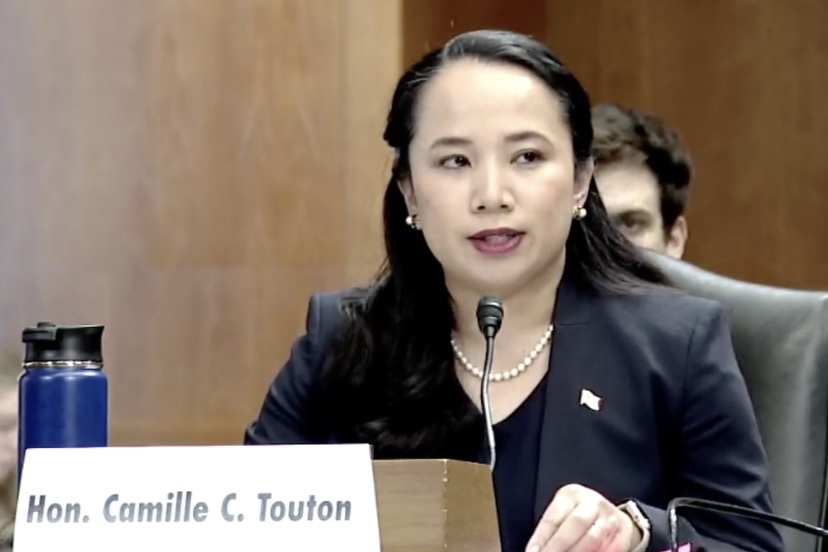Photo: Bureau of Reclamation Commissioner Camille Touton testifies before a Senate committee in June 2022. Screenshot courtesy U.S. Senate Committee on Energy & Natural Resources.
You have a sofa, a La-Z-Boy recliner, and a hassock in your living room, and a 400-pound gorilla walks in. Where does he sit?
Answer: Anywhere he wants.
Let’s say, just for the heck of it, that the doomsayers are right… that the Colorado River and its tributaries, including the San Juan River, will be accumulating less and less water each year as ‘climate change’ grows more severe…
…that there will be high-water years and low-water years (as there have been, all through recorded history)… but that, taken as an average, the availability of water in the American West will never again reach the levels seen in, say, the 1920s or the 1980s.
That is to say, it will drop even further than the levels seen during the 1960s. And will not recover in the lifetime of anyone now living.
The legal allocations from the river — not including water promised to Colorado River Basin Tribes under historical treaties, but still not delivered — have amounted to about 17.5 million acre-feet annually. But the Colorado River and its tributaries have only rarely provided that amount. And the problem has become worse with each passing decade.

One of the doomsayers is the current commissioner of the U.S. Bureau of Reclamation, Camille C. Touton. In June 2022, she gave the seven Colorado River Basin states — Colorado, Wyoming, Utah, New Mexico, Arizona, Nevada and California — 60 days to come up with a plan to reduce their use of Colorado River water by 2 to 4 million acre-feet — around 30 percent of the river’s recent flows. In her opinion, these drastic cuts in water consumption were required to keep the nation’s two largest water reservoirs, Lake Mead and Lake Powell, from eventually drying up.
Ms. Touton told federal legislators that she preferred that the states present their own solution — but if they didn’t, the Bureau would act. “It is in our authority to act unilaterally to protect the system,” Ms. Touton told lawmakers. “And we will protect the system.”
This was perhaps the first announcement ever by a Bureau of Reclamation official to go viral.
The 60-day deadline came and went, however. The states produced no plan for the cuts the Bureau demanded, and the Bureau didn’t present a plan of its own.
It’s one thing to have the authority to act unilaterally, and quite a different thing to actually use that authority.
But as Cyndi Lauper reminded us many years ago… money changes everything. And when 80% of the Colorado River flows to farmers — most often, agricultural corporations — then we can expect the money to flow in the same general direction.
In May 2023, the Biden Administration was finalizing agreements to pay an estimated $1.2 billion in taxpayer dollars to agricultural corporations in California to temporarily fallow their fields… and to cities in Arizona to stop reduce the irrigation of lawns and golf courses.
California irrigation districts legally entitled to the most river water were competing for nearly $900 million of those funds, according to interviews with key negotiators and funding announcements.
“This feels like a shakedown,” University of New Mexico water policy professor John Fleck wrote at the time. “If you don’t pay us a big pile of federal cash, we’ll just run Lake Mead to deadpool. Or, alternatively, if you don’t pay us a big pile of federal cash, we’ll drag the Colorado River Basin into litigation that will make the river ungovernable, a sort of institutional deadpool.
“Either way, it’s a shakedown.”
The deal was still not finalized earlier this month, when the federal government and Imperial Irrigation District on Friday unveiled a key environmental assessment of a potential huge Colorado River conservation deal that could save nearly 1 million acre-feet of water through 2026 — and yield the Imperial Irrigation District and its agricultural corporation members as much as $700 million in public funds.
A reduction of 1 million acre-feet spread over three years… is not quite the same as a reduction of 2 to 4 million acre-feet per year suggested by Commissioner Touton. But maybe that’s all the taxpayers could afford to pay farmers… to stop producing?
I’m wondering if Archuleta County ranchers will eventually be able to climb aboard the gravy train, and get paid to not grow hay.
Disclosure: I currently serve as a volunteer on the Pagosa Area Water and Sanitation District (PAWSD) Board of Directors, but this editorial reflects only my own personal opinions and not necessarily the opinions of the PAWSD Board as a whole.
There are a select number of water-thirsty crops that should never be grown in an arid desert that’s running out of water. Near the top of the ‘naughty list’ are these crops:
1. Almonds
2. Alfalfa
3. Avocados
4. Sugarbeets
5. Peaches
6. Hay
7. Cotton
All of these crops are grown in the Lower Basin states by the corporations that are currently demanding $1.2 billion in federal funding as a ransom payment to stop irrigating their crops.
Which is not to say that Colorado ranches and farms are necessarily more sustainable. Five of these water-demanding crops are grown in our state. This year, USDA expects Colorado farmers to harvest 600,000 acres of alfalfa, 490,000 acres of hay, 21,000 acres of sugarbeets, and 16,500 tons of peaches.
So, more than 1 million acres of feed for cows and other livestock, most of it irrigated with publicly-owned Colorado water. In the Upper Basin states, alfalfa and hay crops soak up 90% of all irrigation water — far more than goes to cities, towns, commercial and industrial uses.
An acre-foot of water can cover an acre of land one foot deep. An alfalfa or hay crop in the arid Southwest requires about 4 acre-feet per acre, annually. If all of Colorado’s alfalfa and hay farmers were offered the same deal as the Imperial Irrigation District, our state’s crop — sans irrigation — would be worth maybe $2.8 billion in federal subsidies.
About the only common crop that requires more irrigation than alfalfa is almonds. These are grown all across California, but particularly in the Imperial Irrigation District. You can learn more about the unsustainability of almonds, here.
Back to the joke about the 400-pound gorilla. The gorilla, in this case, is corporate agriculture, which has been diverting, for who knows how many decades, more water than it has the legal right to divert. But they’re willing to temporarily stop irrigating some of their acreage, if the federal government is willing to pay $700 per acre-foot of water to ensure that they aren’t growing crops they shouldn’t be growing in the first place. This plan might allow Lake Mead and Lake Powell to recover somewhat… but it’s a long range solution, I presume, only if the federal government is willing to keep on paying, forever.
Based on recent statements by Commissioner Camille Touton, the Bureau of Reclamation has the authority to control the amount of water drawn out of our federal reservoirs, without having to pay off extortionists. But that only another presumption on my part.

All this being said, I sometimes add a dash of almond milk to my morning coffee.
But I feel guilty doing it.

